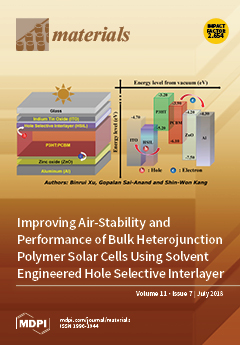This study investigated the influences of acidity, ethanol, and pigment on the optical properties, microhardness, and surface roughness (R
a) of a nanohybrid dental composite resin. A total of 108 disc-shaped specimens were fabricated using a nanohybrid dental composite and allocated into
[...] Read more.
This study investigated the influences of acidity, ethanol, and pigment on the optical properties, microhardness, and surface roughness (R
a) of a nanohybrid dental composite resin. A total of 108 disc-shaped specimens were fabricated using a nanohybrid dental composite and allocated into 36 different storage solutions according to the levels of pH (2.0, 3.0, 4.0, and 5.5), ethanol (0%, 20%, and 40%), and anthocyanin pigment (0%, 2.5%, and 12.5%). Measurements of the colorimetric parameter and the amount of color change (ΔE), translucency parameter (TP), microhardness, and surface roughness (R
a) were performed at 24 h (baseline), 1-, 2-, 3-, and 4-weeks. Repeated measures of analysis of variance (ANOVA) with a Tukey honestly significant difference test and Pearson correlation analysis were carried out (α = 0.05). Pigment of 12.5% or 40% ethanol significantly increased the ΔE (
P < 0.001,
P = 0.048, respectively). Pigment of 2.5% or 12.5% significantly decreased the TP (
P = 0.001,
P < 0.001, respectively). Microhardness of composite resin stored in pH 2.0, 3.0, 4.0 solution was lower than that for pH 5.5 (
P < 0.001). Pigment, ethanol, and pH did not influence the R
a. TP change and ΔE, and R
a and ΔE had a significant positive correlation (
P < 0.05). In conclusion, pigment and ethanol levels influenced the optical properties and acidity affected the microhardness of composite resin.
Full article






